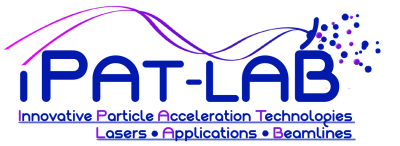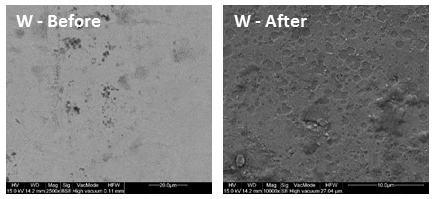The manufacturing sector is currently a key driver in industry. In the US, in 2012 it accounted for approximately 16 percent of global GDP and 14 percent of employment[1]. Strong effort is put into the advanced manufacturing of materials for very specific applications. Part of these applications use materials exposed to harsh conditions such as when exposed to high-energy density fluence. Examples can be found in high-energy density/astrophysics, aero spatial applications (including aircraft industry), or energy production[2] (nuclear plants, but also Inertial or Magnetic Confinement Fusion (ICF – MCF) facilities). Testing the stress of these materials before they go into production is of vital importance if one wants to ensure a safe operation of the system and prevent failures that can have devastating consequences. One of the sectors, where these criteria are most stringent, is in the field of nuclear reactors and energy producing facilities. As an example, the operation of those facilities imposes the use of materials with improved mechanical, thermal, and electrical properties, for components directly exposed to the plasma fusion process (plasma facing materials – PFM). These materials are expected to maintain the required safety conditions for the very long operation times of the reactor. For example, the safety conditions for the upcoming DEMO reactor located at the ITER facility[3] [4] require that any structure in the reactor should not approach its melting temperature under any accidental conditions, and fix the solicitation, measured in displacements per atoms (dpa), in a 5 years cycle at 30 dpa for the first wall materials and 15 dpa for the divertors. In aerospace applications, the maximum accepted erosion is in the order of a few microns per operational month. In general, materials in those fields should have good mechanical resistance (high Young’s modulus and low stiffness), good thermal resistance (high thermal stability and fusion heat), low erosion and should be light in weight. Candidates possessing these properties are usually Carbon based materials with high Z. Indeed, these materials are characterized by higher melting points (in the order of 3000 °C), higher heat of fusion (in the order of 35 kJ/mol), and higher resistance to erosion under energetic sputtering[5] [6].
The most employed material, e.g. for nuclear reactors, is Tungsten and its alloys or composites, which show good thermal stability and low erosion. Many references in literature indicate nanostructured tungsten or composites of tungsten and high atomic number (Z) elements as good candidate for structural materials, armour materials, and divertors. While the design of advanced materials for harsh environments is a challenge that many groups and industries are pursuing, there exist only very few facilities for testing their employment in the operational environment. This limits the ease and efficiency of advanced manufacturing in this domain. Therefore, the design and realization of new materials able to withstand extreme conditions and as such to improve the security of materials operating in harsh conditions calls for a quick, reliable and easy applicable stress analysis to well define the material properties and the lifetime before implementation in its environment. In general, material stress tests simulated in laboratories are based on the irradiation of materials with high energetic (conventional) particle beams, which simulate the deposited energy and the dpa of a testing material. Three methods are currently available: (i) the electron beam simulation of disruption heat flux, (ii) the He beam irradiation, and (iii) the exposure to laboratory He plasma. All these methods give information on the changes of the material properties but only the combination of all methods can give a complete analysis of the material response to stress. Moreover, these tests require long exposure times while the combination of all the effects of a harsh environment (e.g. nuclear reaction or aero-space conditions) are extremely complex to model and simulate computationally. As an example, the experimental research on the PFM by the fusion community has been limited to just a few programs in the US connected to the NIF project in the nineties and HAPL during the last decade[7],[8]. The difficulty to reproduce the environment of a fusion reactor (short pulses, high fluence and high energy spectral ranges of X-rays and ions) strongly limits the capacity of one single methods of material science in the stress test of materials. From the available studies, particular interesting are the repetitive thermal load investigations by the Dragon Fire laser[9], the X-ray damage simulated using Z-pinch machines[10],[11] and the ion effects modeled either by RHEPP I at the Sandia National Laboratories[12] or by the inertial electrostatic confinement device at the University of Wisconsin-Madison[13].
In this research activity we want to use laser-driven protons to perform stress test on materials and with this to pave the floor for testing the stress on newly developed nanostructured target that can be employed in harsh environment (e.g. nuclear power reactors, ICF-MCF facilities, etc).
[1] J. Manyika et al., Manufacturing the future: the next era of global growth and innovation, McKinsey Global Institute (2012)
[2] X. Xia, Q. Chen, S. Huang, J. Lin, C. Hu, Z. Zhao, Journal of Alloys and Compounds, 644, 308-316 (2015)
[3] R. Toschi, P. Barabaschi, D. Campbell, F. Elio, D. Maisonnier, D. Ward, Fusion Engineering and Design, 163, 56-57, (2001)
[4] H. Bolt, V. Barabash, W. Krauss, J. Linke, R. Neu, S. Suzuki, N. Yoshida, Journal of Nuclear Materials, 66, 329-333, (2004)
[5] P. Vladimirov, A. Moslang, Journal of Nuclear Materials, 233, 329-333 (2004)
[6] M. Rieth et al., Journal of Nuclear Materials, 432, 482 (2013)
[7] R.A. Raffray and the HAPL team, J. Nucl. Mater. 347, 178 (2005).
[8] J.D. Sethian et al., IEEE Trans. Plasma Sci. 38, 690 (2010)
[9] http://aries.ucsd.edu/HAPL/MEETINGS/
[10] J.F. Latkowski, R.P. Abbott, R.C. Schmitt and B.K. Bell, J. Nucl. Mater. 347, 255 (2005).
[11] T.J. Tanaka, G.A. Rochau, R.R. Peterson and C.L. Olson, J. Nucl. Mater. 347, 244 (2005).
[12] T.J. Renk, P.P. Provencio, T.J. Tanaka, C.L. Olson, R.R. Peterson, J.E. Stolp, D.G. Schroen and T.R. Knowles, J. Nucl. Mater. 347, 266 (2005).
[13] S.J. Zenobia, R.F. Radel, B.B. Cipiti and G.L. Kulcinski, J. Nucl. Mater. 389, 213 (2009).

